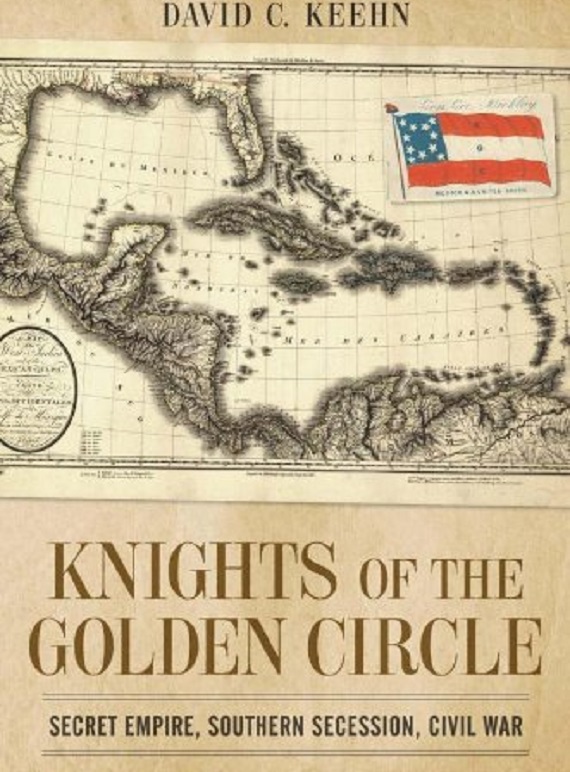A review of Knights of the Golden Circle: Secret Empire, Southern Secession, Civil War by David C. Keehn (LSU, 2013).
“Maybe,” “Likely,” “It seems that.”
Those are hardly the words of an author certain of the truth of his thesis, but these are indeed the words David C. Keehn uses in his book, Knights of the Golden Circle: Secret Empire, Southern Secession, Civil War.
According to the information on the inside flap of the dust jacket, Keehn’s book purports to be “based on years of exhaustive and meticulous research” and to be “the first comprehensive analysis of the Knights of the Golden Circle.”
It certainly is an analysis of the KGC and it is, in places, the product of praiseworthy research and analysis. Unfortunately, Keehn’s promised insight is alloyed with the attempt to make conjecture a reality.
First, though, there is one undeniable strength of the book: his painstaking investigation of the life of one of the chief figures of the KGC, George Bickley.
Keehn can’t help but guess about most of the history of this secret organization (it is, after all, secret), skimming across the surface of known history, but he drills down on Bickley’s activities in the 1850s and his hand in founding the KGC and in forming its leadership structure.
The light Keehn shines on Bickley illuminates much of the early KGC’s purposes, as well. While it is true that the author fills in gaps with lesser material, the section of his book devoted to Bickley and the birth of the KGC is constructed with solid stuff.
For those interested in new, previously unpublished “inside” information on the shadowy inner-working of the Knights of the Golden Circle will be disappointed in Keehn’s book. Those seeking to add academic substance to their Civil War library will benefit from the book, however.
The bulk of the brilliant and beneficial parts of the book is found in Keehn’s research into the organizational details of the KGC, and the trifurcation of its mission.
According to Keehn’s research — which, in this area, seems unassailable — the Knights were divided into three “degrees.”
The first degree was called the “Company” and it was the military branch and it was given the name Order of the Iron Hand.
Second, came the commercial degree, called the Order of the True Faith.
Finally, there was the Division, given the title Knights of the Columbian Star.
All of the degrees, orders, and members of the KGC were, Keehn reports, held together in a loose confederation of “state and local militia leaders that helped coordinate the drive for secession.”
The KGC’s secrecy and its insistence on nothing less than full-throated fidelity to the goals and first principles of the organization ultimately, Keehn claims, proved to the be the raw materials upon which another clandestine paramilitary organization would build its own power base. That group: the KKK.
All of the respectable research performed and published by Keehn is nearly completely overshadowed by the manifold suppositions, exaggerations, and exegetical gymnastics on display in the section purporting to reveal the KGC’s role in the attempted and later the successful assassination of Abraham Lincoln.
The narrative throughout these couple of dozen pages is rife with Keehn’s interpretations of otherwise innocuous statements by pro-Southern politicians to be obvious references to the KGC’s hidden but undeniable hand moving pulling the strings of assassination.
What’s more, every mention by any player in this deadly drama of his unwillingness to divulge the identity of some alleged unnamed co-conspirator is assumed by Keehn to be a veiled reference to the KGC and its vestigial influence and insidiousness.
This theatrical bent is on display in the parts of the book pointing to KGC’s purported possession of such immeasurable influence that it could manufacture the secession of Texas and Virginia. The evidence backing up Keehn’s “if this then that” thesis is lacking, severely lacking.
One undisputed fact that gets short (nearly non-existent) shrift in Keehn’s recitation of the key players in the spreading of the secessionist spirit is the work of the numerous other groups that moved behind the scenes. Keehn’s retelling of the drama would have the reader believe that the KGC was omniscient, omnipotent, and omnipresent in every southern state, always at the right time and at the right place.
Rubbish.
With the foregoing in mind, those desiring an understanding of antebellum, bellum, and postbellum America and the dramatis personae that played significant parts in those acts — both on stage and behind the scenes — would be well served in considering Keehn’s contribution to the Civil War corpus. He is a reputable researcher and his narrative is readable and enjoyable.
Just keep in mind that during the 1850s and 1860s the smoke of secrecy was not always a sign of a fire set by the secessionists of the KGC.







